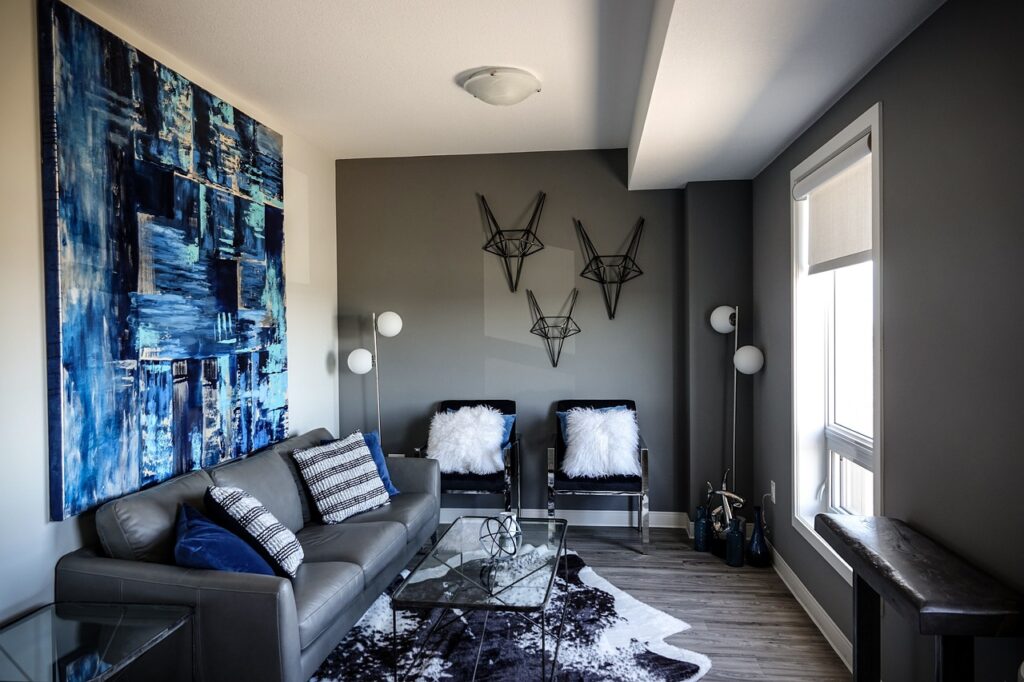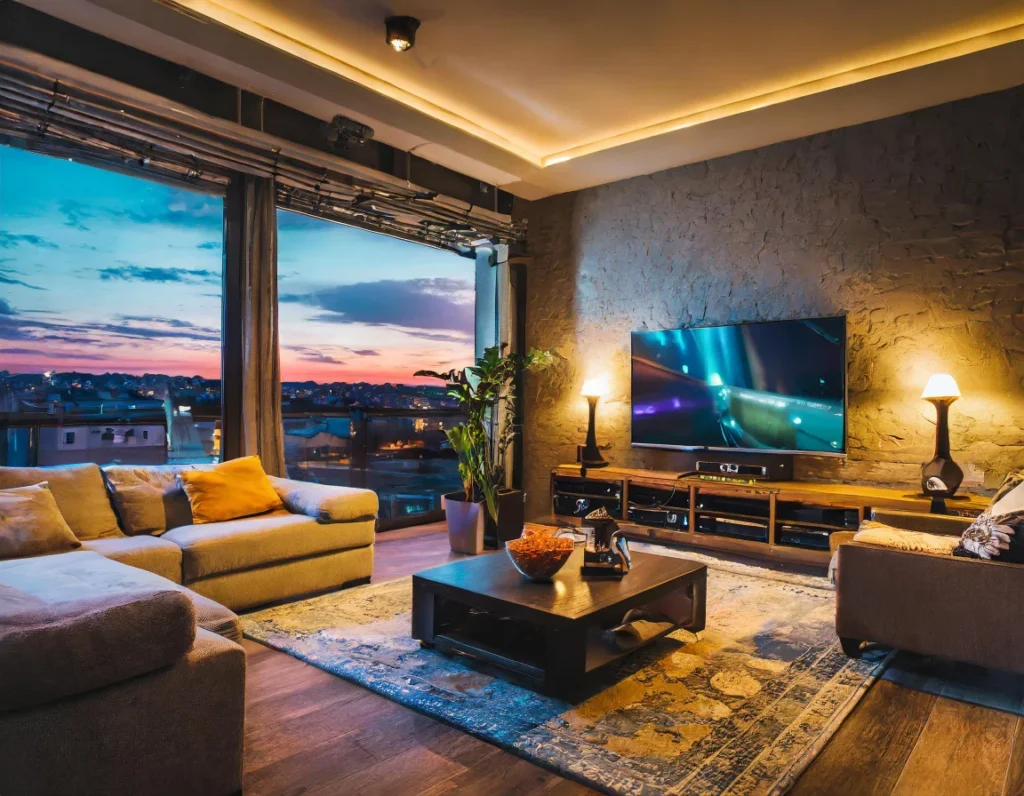Designing a living room layout with a fireplace that accommodates both a fireplace and a TV can be a balancing act between functionality and style. The fireplace is often a natural focal point, while the television is a central element of modern living spaces. This article explores various layout options harmonizing these two features, ensuring a comfortable and aesthetically pleasing living room environment. From optimizing furniture arrangements to strategic TV placements, we provide insights into creating a living room layout that enhances the enjoyment of your fireplace without compromising on the pleasure of watching TV.
Contents
- 1 Key Takeaways
- 2 Optimizing Furniture Arrangement Around the Fireplace
- 3 Strategic TV Placement for a Functional Living Space
- 4 Design Considerations for Long and Narrow Living Rooms
- 5 Incorporating the Fireplace as a Focal Point
- 6 Conclusion
- 7 Frequently Asked Questions
- 7.1 What is the best way to arrange furniture around a fireplace in a living room?
- 7.2 Should I place my TV over the fireplace?
- 7.3 How can I incorporate both a fireplace and a TV in my living room layout?
- 7.4 What are some design considerations for a long and narrow living room with a fireplace?
- 7.5 How can I make the fireplace the focal point of my living room?
- 7.6 What should I do if I don’t have an open wall for the TV adjacent to the fireplace?
Key Takeaways
- U-shaped seating arrangements around the fireplace can create a luxurious atmosphere while encouraging social interaction.
- Placing the TV on an adjacent or opposite wall to the fireplace avoids clutter and maintains the fireplace as a focal point.
- For a functional dual-use space, consider a two-for-one layout with sofas facing both the TV and the fireplace.
- In long and narrow living rooms, maximize natural light and consider modular furniture for space efficiency.
- Balance the aesthetics and functionality by using decorative elements to complement the fireplace without overshadowing the TV.
Optimizing Furniture Arrangement Around the Fireplace
Creating a U-Shaped Seating for a Luxurious Atmosphere
A U-shaped seating arrangement exudes luxury and ensures everyone has an unobstructed view of the fireplace. Begin with a central sofa facing the hearth, flanked by loveseats or armchairs to complete the U. This layout is perfect for large living rooms, creating an elegant and formal atmosphere.
- Position sofas and chairs to form a U-shape
- Central sofa faces the fireplace
- Flank with loveseats or armchairs
- Ideal for spacious living areas
The U-shaped configuration not only focuses on the fireplace as the main attraction but also facilitates easy conversation, making it a prime choice for those who entertain guests frequently.
By avoiding the placement of a TV over the fireplace, you maintain the aesthetic integrity of the space. Consider alternative walls for the TV to keep the living room functional without compromising on style.
Angling Seating for Intimacy and Focus on the Fireplace
Angling your seating towards the fireplace creates a cozy and intimate setting, perfect for quiet evenings or engaging conversations. By positioning sofas and chairs to face the hearth, you establish the fireplace as the room’s heart.
The Intimate Partition—section off the fireplace to define a more private zone. Center the couch to face the fireplace, with a coffee table in between, and arrange additional seating on the sides. This layout not only enhances the warmth and ambiance but also fosters a sense of closeness among those seated.
Ensure a comfortable distance from the fireplace to the seating. A minimum of 2–3 feet allows for a pleasant heat without overwhelming guests.
Consider the room’s flow and how each seating position relates to other focal points. For example, a chair angled towards the room encourages interaction with those standing, while also enjoying the fireplace’s warmth.
Encouraging Conversation with Perpendicular Sofa Placement
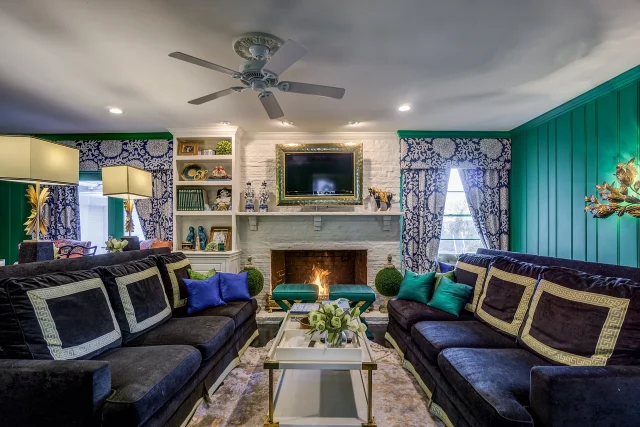
Positioning sofas perpendicular to the fireplace fosters an inviting atmosphere for dialogue. Place one sofa facing the fireplace, creating a direct line of sight to the warmth and glow. On the opposite side, arrange a second sofa or chairs at a right angle, establishing an L-shaped seating that encourages guests to turn towards each other.
- Use an Area Rug to Anchor the Space
A large area rug can define the seating area, particularly in open-plan living rooms. It serves as a visual anchor, bringing coherence to the furniture layout.
By setting sofas perpendicular, you create a natural flow in the room. This layout not only facilitates conversation but also maintains an open feel, avoiding a cluttered or closed-off appearance.
In this configuration, consider adding a small chair or beanbag next to the fireplace. This additional seating can face the center of the room, inviting more open interactions and socialization.
Strategic TV Placement for a Functional Living Space
Avoiding TV Over the Fireplace: Alternative Wall Options
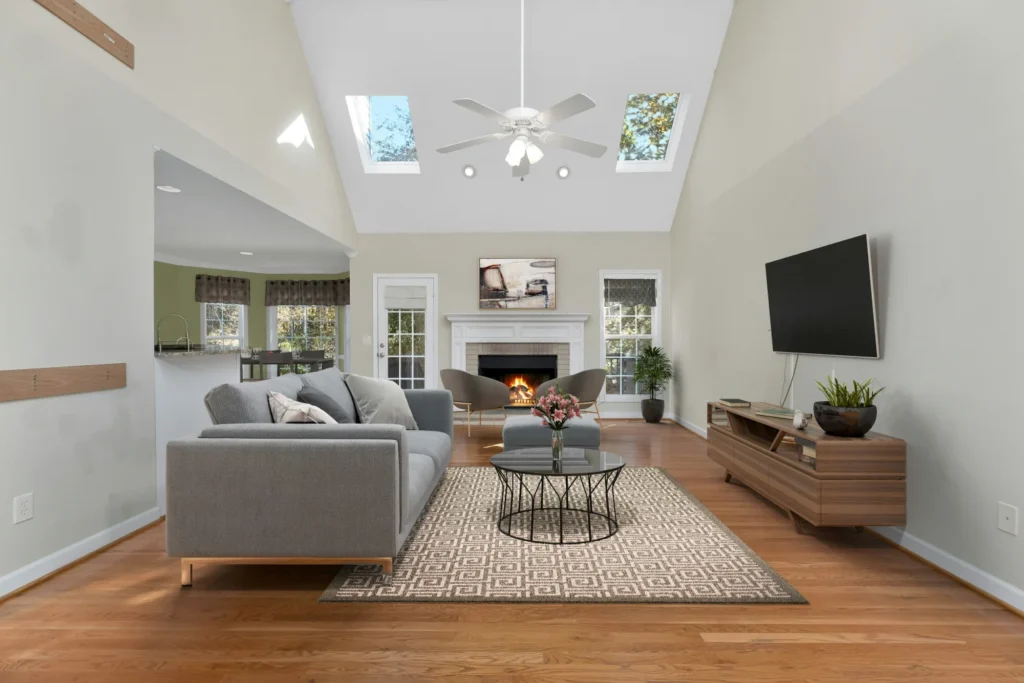
Mounting the TV over the fireplace can lead to a cluttered look and uncomfortable viewing angles. Consider alternative wall options to maintain the fireplace as a distinct focal point. An adjacent wall can offer a suitable location, keeping the TV at eye level for optimal comfort.
- Choose an open wall that doesn’t compete with the fireplace’s visual appeal.
- Utilize a gallery wall to integrate the TV with art, balancing aesthetics and functionality.
- Consider TV concealment options like barn doors or art screens for a tidy appearance when not in use.
By strategically placing the TV on a different wall, you create a harmonious balance in the room, ensuring both the fireplace and television have their own space.
Evaluate the room’s layout and consider the distance between the TV and seating. The goal is to find a spot that doesn’t detract from the fireplace’s charm while preserving the room’s functionality.
The Two-for-One Layout: Adjacent TV and Fireplace Viewing
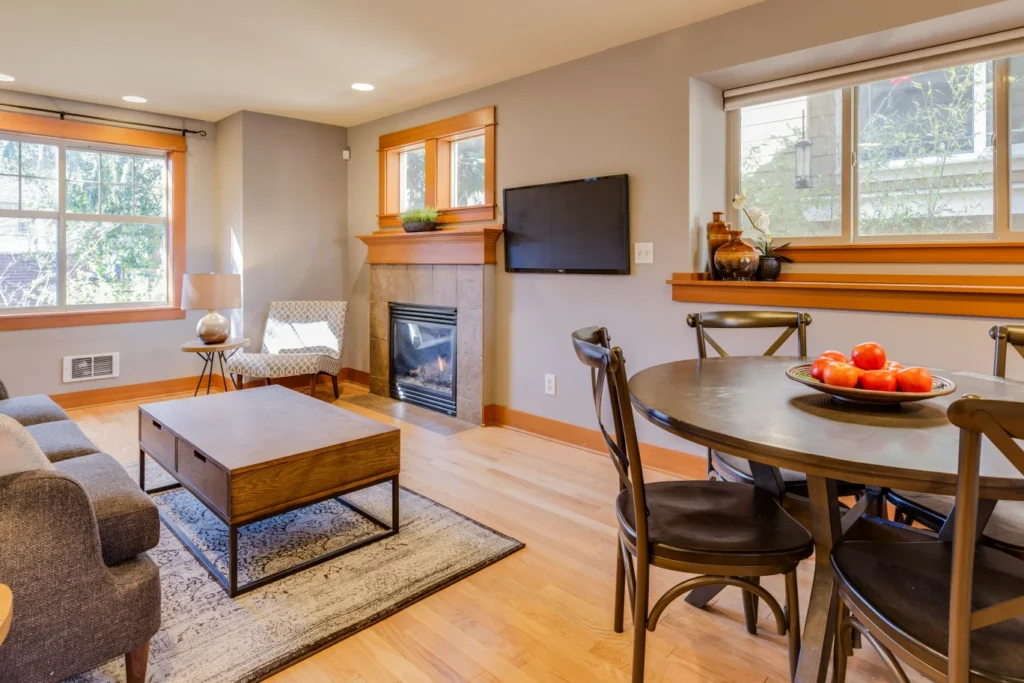
Photo by Francesca Tosolini on Unsplash
Maximize your living space by adopting the Two-for-One layout, where the TV and fireplace coexist harmoniously. This arrangement is ideal for those who enjoy the warmth of the fireplace and entertainment from the TV without compromising on style or functionality.
- Mount the TV on the wall adjacent to the fireplace.
- Place an L-shaped couch or two sofas in a strategic position, allowing one side to face the TV and the other the fireplace.
This layout not only saves space but also offers a versatile living area, where you can switch your focus from a cozy fire to your favorite show with ease.
For rooms lacking an open wall next to the fireplace, consider setting sofas to face each other with the TV on the opposite wall. This variation maintains a clear view of both focal points, ensuring a balanced and inviting atmosphere.
Facing Sofas and Opposite Wall TV for Balanced Design
A balanced living room layout can be achieved by positioning two sofas to face each other, creating a symmetrical and inviting space. Place the television on the wall opposite the fireplace to ensure that both focal points are easily viewable from the seating area. This arrangement allows for a clear line of sight to the TV while maintaining the fireplace as a central feature.
Flexibility is key in this layout, allowing residents to switch their focus between the warm ambiance of the fireplace and the entertainment provided by the television. Consider the following points for an effective setup:
- Ensure sofas are spaced evenly for optimal viewing and traffic flow.
- Use a central coffee table or side tables for functionality and balance.
- Incorporate swivel chairs for additional seating that can be adjusted as needed.
In this layout, the room’s symmetry provides a harmonious aesthetic, while the strategic placement of furniture maximizes the use of space and comfort.
Remember to account for the size of your sofas and the dimensions of your living room to maintain proportion and avoid overcrowding. The goal is to create a cohesive environment that serves both relaxation and entertainment purposes.

How to Remove Wallpaper: Best Tips
Design Considerations for Long and Narrow Living Rooms
Maximizing Natural Light from Windows
Maximize the view and the natural light by considering the placement and size of windows. Large, unobstructed windows not only provide a visual connection to the outdoors but also allow for ample sunlight to enter the space.
Incorporate reflective surfaces such as mirrors to bounce light around the room, making it feel brighter and more open. Strategic placement of mirrors can effectively double the light entering through the windows.
- Upgrade to taller doors and larger windows to enhance natural light.
- Align doors and windows at the same height to create a sense of spaciousness.
- Avoid placing large furniture in front of windows to prevent blocking light.
By optimizing window design and room layout, you can create an inviting atmosphere that capitalizes on natural light, making your living room feel more expansive and welcoming.
Furniture Downsizing and Modular Options for Space Efficiency
In the quest for a spacious and airy living room, downsizing furniture is key. Opt for pieces that serve multiple purposes and fit snugly into your layout. Consider a modular sofa that can be reconfigured to suit different occasions, or a coffee table with hidden storage to minimize clutter.
- Choose furniture that can be easily moved or tucked away
- Look for multi-functional pieces like ottomans with storage
- Invest in wall-mounted shelves to free up floor space
Embrace the minimalist approach to make your living room feel larger and more inviting.
Remember, the goal is to create a sense of openness without sacrificing comfort. By selecting the right furniture, you can enjoy a living room that’s both stylish and functional.
Creating a Floating Seating Arrangement for Flexibility
In the quest for a versatile living room layout, creating a floating seating arrangement offers unparalleled flexibility. This approach allows for easy reconfiguration of your space to suit different occasions and activities.
Floating furniture is not anchored to walls or other permanent fixtures, making it simple to shift around for optimal viewing, whether you’re cozying up to the fireplace or enjoying a movie night. Here’s how to achieve this dynamic setup:
- Start with a central coffee table as an anchor for the arrangement.
- Surround it with lightweight chairs and sofas that can be easily moved.
- Incorporate multi-functional pieces like ottomans that serve as extra seating or tables.
By keeping the space open and adaptable, you encourage socialization and prevent the room from feeling too formal or static.
When considering the placement of your TV, take inspiration from the snippet: Do a false back wall and mount the TV on it with an articulating arm, allowing for adjustments in viewing angles. This setup should be positioned to complement the fireplace, with additional storage solutions like cabinets to maintain a clutter-free environment.
Incorporating the Fireplace as a Focal Point

Designing a Formal Living Room with Fireplace Centricity
In a formal living room, the fireplace naturally commands attention. Positioning furniture to complement this focal point enhances the room’s elegance. A sofa perpendicular to the fireplace, flanked by two love seats, creates a luxurious and inviting space.
- Position sofas and chairs in a U-shape
- Angle seating towards the fireplace
- Encourage conversation with perpendicular sofa placement
Designers often advise against placing a TV over the fireplace to avoid clutter. Instead, consider an adjacent or opposite wall for the television, maintaining the fireplace’s prominence.
The formal layout should exude luxury while remaining functional. It’s about striking a balance between aesthetics and practicality, ensuring the space is both beautiful and livable.
Balancing Aesthetics and Functionality in Fireplace-Centric Layouts
Achieving harmony between beauty and practicality in a living room with a fireplace requires thoughtful placement of furniture and decor. Ensure ample space between seating and the fireplace to highlight its role as the centerpiece while maintaining safety and comfort. Opt for a layout that allows for unobstructed views of the fire, creating a warm and inviting atmosphere.
- Consider the fireplace as a substantial piece of furniture in the room.
- Arrange seating to facilitate both the enjoyment of the fireplace and the functionality of the living space.
- Experiment with different configurations to find the perfect balance for your home.
By treating the fireplace as a central element, you can design a layout that serves both aesthetic appeal and practical needs without compromising on either.
Remember to accentuate the fireplace with carefully curated decor such as artwork or a decorative mirror, enhancing its visual impact and complementing the room’s overall design.
Utilizing Decorative Elements to Highlight the Fireplace
To accentuate the fireplace, consider a minimalist approach with decorative elements. Choose cohesive colors to unify the room’s aesthetic, ensuring the fireplace remains the star. A well-placed mirror or artwork above the mantle can magnify the fireplace’s impact, making the room feel larger and more inviting.
- Frame the fireplace with plants or flowers for a natural ambiance.
- Display favorite photographs or keepsakes on the mantle.
- Consider a statement piece of art to draw the eye.
The right decor can transform your fireplace into a captivating focal point, enhancing the overall charm of your living space.
Avoid cluttering the space. Instead, use decor to create a beautiful focal point that envelops the fireplace, such as trim or built-in bookcases painted in an accent color. This strategic use of decor not only highlights the fireplace but also adds depth and character to the living room.
Conclusion
Designing a living room that accommodates both a fireplace and a TV requires thoughtful consideration of space, functionality, and aesthetics. Throughout this article, we’ve explored various layouts that prioritize comfort and style, from U-shaped seating arrangements that celebrate the fireplace as a central focal point to strategic placement of the TV to maintain balance and harmony in the room. Remember, the key is to create a space that feels inviting and serves the needs of your household, whether that’s fostering conversation, enjoying a cozy fire, or indulging in entertainment. Experiment with different configurations and don’t shy away from rearranging until you find the perfect setup that makes your living room a cherished haven in your home.
Frequently Asked Questions
What is the best way to arrange furniture around a fireplace in a living room?
The best arrangement often involves positioning sofas and chairs in a U-shape around the fireplace for a luxurious atmosphere, or angling seating toward the fireplace for intimacy. For a conversational setup, place a sofa perpendicular to the fireplace and additional chairs opposite the sofa.
Should I place my TV over the fireplace?
Designers typically advise against placing a TV over the fireplace as it can clutter the space and create ergonomic issues. Instead, consider mounting the TV on an adjacent or opposite wall for better viewing and aesthetics.
How can I incorporate both a fireplace and a TV in my living room layout?
For a dual-purpose layout, mount the TV on the wall adjacent to the fireplace and arrange seating so that one side faces the TV and the other faces the fireplace. This allows you to switch focus based on whether you’re watching TV or enjoying the fireplace.
What are some design considerations for a long and narrow living room with a fireplace?
Maximize natural light from windows, consider downsizing furniture or using modular options for space efficiency, and create a floating seating arrangement to maintain flexibility and avoid a cramped feeling.
How can I make the fireplace the focal point of my living room?
Design the living room with the fireplace as the centerpiece, using decorative elements to highlight it. Arrange seating to face the fireplace and balance the layout with functionality in mind, ensuring the space is used and enjoyed.
What should I do if I don’t have an open wall for the TV adjacent to the fireplace?
If there’s no open wall next to the fireplace, set two sofas to face each other with the TV on the wall opposite the fireplace. This creates a balanced design and allows for an unobstructed view of the TV and easy enjoyment of the fireplace.

